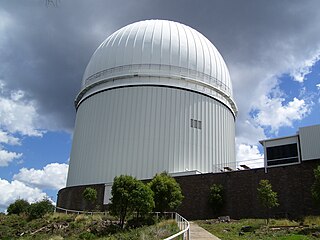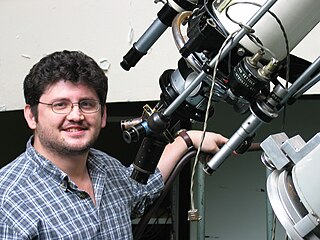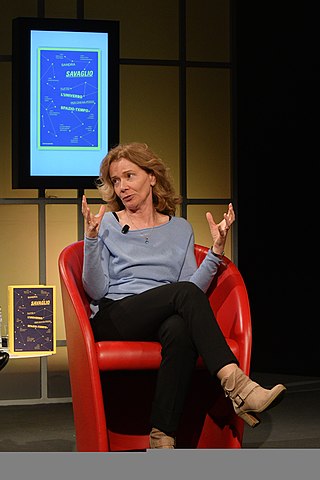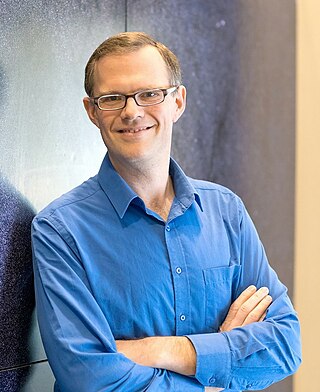Related Research Articles

The National Optical Astronomy Observatory (NOAO) was the United States national observatory for ground-based nighttime ultraviolet-optical-infrared (OUVIR) astronomy. The National Science Foundation (NSF) funded NOAO to provide forefront astronomical research facilities for US astronomers. Professional astronomers from any country in the world could apply to use the telescopes operated by NOAO under the NSF's "open skies" policy.

The Australian Astronomical Observatory (AAO), formerly the Anglo-Australian Observatory, was an optical and near-infrared astronomy observatory with its headquarters in North Ryde in suburban Sydney, Australia. Originally funded jointly by the United Kingdom and Australian governments, it was managed wholly by Australia's Department of Industry, Innovation, Science, Research and Tertiary Education. The AAO operated the 3.9-metre Anglo-Australian Telescope (AAT) and 1.2-metre UK Schmidt Telescope (UKST) at Siding Spring Observatory, located near the town of Coonabarabran, Australia.
The Sloan Digital Sky Survey or SDSS is a major multi-spectral imaging and spectroscopic redshift survey using a dedicated 2.5-m wide-angle optical telescope at Apache Point Observatory in New Mexico, United States. The project began in 2000 and was named after the Alfred P. Sloan Foundation, which contributed significant funding.

Mount Stromlo Observatory located just outside Canberra, Australia, is part of the Research School of Astronomy and Astrophysics at the Australian National University (ANU).

An astronomical survey is a general map or image of a region of the sky that lacks a specific observational target. Alternatively, an astronomical survey may comprise a set of images, spectra, or other observations of objects that share a common type or feature. Surveys are often restricted to one band of the electromagnetic spectrum due to instrumental limitations, although multiwavelength surveys can be made by using multiple detectors, each sensitive to a different bandwidth.

Bryan Malcolm Gaensler is an Australian astronomer based at the University of Toronto. He studies magnetars, supernova remnants, and magnetic fields. In 2014, he was appointed as Director of the Dunlap Institute for Astronomy & Astrophysics at the University of Toronto, after James R. Graham's departure. He is currently the co-chair of the Canadian 2020 Long Range Plan Committee with Pauline Barmby.

Roberto Abraham, FRSC is a Canadian astronomer and is Professor of Astronomy at the University of Toronto and a Fellow of the Royal Society of Canada.

Christopher Stubbs is an experimental physicist currently on the faculty at Harvard University in both the Department of Physics and the Department of Astronomy. He is the current Dean of Science at Harvard University and a former Chair of Harvard's Department of Physics.

Roger Llewelyn Davies is a British astronomer and cosmologist, one of the so-called Seven Samurai collaboration who discovered an apparent concentration of mass in the Universe called the Great Attractor. He is the Philip Wetton Professor of Astrophysics at Oxford University. His research interests centre on cosmology and how galaxies form and evolve. He has a longstanding interest in astronomical instruments and telescopes and developed the scientific case for the UK's involvement in the 8m Gemini telescopes project. He has pioneered the use of a new class of astronomical spectrograph to measure the masses and ages of galaxies, as well as search for black holes in their nuclei. He is the founding Director of the Oxford Centre for Astrophysical Surveys which is funded by the Hintze Family Charitable Foundation.
ARC Centre of Excellence for All-Sky Astrophysics was a collaboration of international astronomers dedicated to wide field astronomy. It was formally launched on 12 September 2011, at Sydney Observatory and ceased in 2018.

Warrick John Couch is an Australian professional astronomer. He is currently a professor at Swinburne University of Technology in Melbourne. He was previously the Director of Australia's largest optical observatory, the Australian Astronomical Observatory (AAO). He was also the president of the Australian Institute of Physics (2015–2017), and a non-executive director on the Board of the Giant Magellan Telescope Organization. He was a founding non-executive director of Astronomy Australia Limited.

Amanda Elaine Bauer is an American professional astronomer and science communicator. She is the Deputy Director and Head of Science and Education at Yerkes Observatory in Williams Bay, Wisconsin. She was previously based in Tucson, Arizona, working as Head of Education and Public Outreach at the Large Synoptic Survey Telescope. From 2013 to 2016 she was a Research Astronomer at the Australian Astronomical Observatory (AAO). Her principal field of research concerns how galaxies form, how they create new stars, and particularly why they suddenly stop creating new stars.

Laura Ferrarese is a researcher in space science at the National Research Council of Canada. Her primary work has been performed using data from the Hubble Space Telescope and the Canada-France-Hawaii Telescope.
George Kildare Miley is an Irish-Dutch astronomer. He holds a professorship at Leiden University, where he served as director of Leiden Observatory from 1996 to 2003.

Sandra Savaglio is an Italian astrophysicist whose research focuses on the "young universe: cosmic chemical evolution, distant galaxies, intergalactic and interstellar medium, and galaxies hosting the most energetic events in the universe: the gamma-ray bursts and the super luminous supernovae.

The WiggleZ Dark Energy Survey was a large-scale astronomical redshift survey carried out on the 3.9 metre Anglo-Australian Telescope (AAT) at the Siding Spring Observatory, New South Wales between August 2006 and January 2011. The name stems from the measurement of baryon acoustic oscillations in the distribution of galaxies.

Peter Lawrence Capak is currently the Architect of Perception Systems at the Oculus division of Facebook. His current focus is developing machine perception technologies, sensors, displays, and compute architectures for the next generation of augmented (AR), mixed (MR) and virtual reality (VR) systems. His research has focused on using physical modeling and advanced statistical methods including artificial intelligence and machine learning to extract information from very large multi-wavelength (hyper-spectral) data sets. He has primarily used this to study structure formation in the universe, cosmology, and the nature of dark matter and dark energy.

Jonathan (Joss) Bland-Hawthorn is a British-Australian astrophysicist. He is a Laureate professor of physics at the University of Sydney, and director of the Sydney Institute for Astronomy.
Virginia Kilborn is a professor and radio astronomer with the Centre for Astrophysics and Supercomputing at Swinburne University and is Swinburne's first Chief Scientist. She researches galaxy evolution by studying their gas content and is working on the surveys of the next generation of radio telescopes, including the Australian SKA Pathfinder.
References
- ↑ "10099 Glazebrook (1991 VB9)". Minor Planet Center. Retrieved 6 March 2017.
- ↑ Swinburne Alumni News
- ↑ Gemini Observatory - the Gemini Deep Deep Survey
- ↑ Casey Kazan; The early universe puzzle [ permanent dead link ], The Daily Galaxy (15 June 2011).
- ↑ "Color Corrected: Johns Hopkins Researchers Say Universe Much Blander Than Before". Associated Press. 8 March 2002. Archived from the original on 3 April 2004.
- ↑ "The WiggleZ Dark Energy Survey". Astronomy and Geophysics. Archived from the original on 24 December 2016. Retrieved 22 December 2016.
- ↑ "Professor Karl Glazebrook named ARC Laureate Fellow". Swinburne University of Technology . 3 August 2018. Retrieved 3 May 2020.
- ↑ 2008 ASP Award Recipients Press Release
- ↑ "MPC/MPO/MPS Archive". Minor Planet Center. Retrieved 6 March 2017.